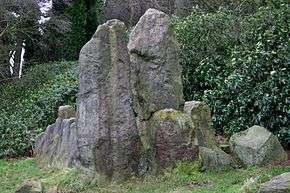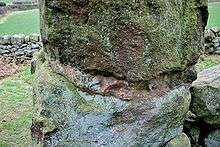The Bridestones
 | |
| Location | near Congleton |
|---|---|
| Region | Cheshire, England |
| Coordinates | 53°9′24.64″N 2°8′31.3″W / 53.1568444°N 2.142028°WCoordinates: 53°9′24.64″N 2°8′31.3″W / 53.1568444°N 2.142028°W |
| Type | Chambered cairn |
| History | |
| Periods | Neolithic |
| Site notes | |
| Condition | damaged |
| Website | see Megalithic Portal |
The Bridestones consist of a chambered cairn, built in the Neolithic Stone Age, near Congleton, Cheshire, England. It was described in 1764 as being 100 metres long and 11 metres wide; it contained three separate compartments, of which only one remains today. The remaining compartment is 6 metres long by 2.7 metres wide, and consists of vertical stone slabs, divided by a now-broken cross slab. The cairn originally had a stone circle surrounding it, with four portal stones; two of these portal stones still remain.[1] The site is protected as a Scheduled Ancient Monument.[2][3][4]
The origin of the cairn's name is unclear. Once legend says that a recently married couple were murdered at the location, and the stones were laid around their grave. Another possibility is that they are named for Brigantia. Alternatively, the Old English word for "birds" was "briddes"; the stones in their original form could have resembled birds, giving rise to "Briddes stones".[5]
Condition in 1766
The state of the site was recorded in 1766 by Henry Rowlands in Mona Antiqua Restaurata.
| “ | There are six upright free stones, from three to six feet broad, of various heights and shapes, fixed about six feet from each other in a semicircular form, and two within, where the earth is very black, mixed with ashes and oak-charcoal. It is apprehended the circle was originally complete, and twenty-seven feet in diameter; for there is the appearance of holes where stones have been, and also of two single stones, one standing east of the circle, at about five or six yards distance, and the other at the same distance from that.
A little west of the above stones are two rough, square tapering stones 4ft. 3in. broad and 2ft. thick, standing at the north and south angles of a kind of artificial stone cave or chest. This is paved with broken pieces of stones about 2 1/2 inches thick, overlaying some pounded whitestone about six inches deep; two inches of the upper part of which are tinged with black, supposed from ashes falling through the pavement which was covered with them and oak-charcoal about two inches thick, along with several pieces of burnt bones. The sides of the cave, if I may so call it, were composed of two unhewn stones about 18 feet in length, six in height and fourteen inches thick at a medium. Each of them is now broken in two. There is a partition stone across the place, about five feet and a half high, and six inches thick. A circular hole is cut through this stone, about nineteen inches and a half in diameter. There remains another place of the same construction but smaller and without any inward partition, about 55 yards distance from this. It is 21⁄2 yards long, 21⁄2 feet broad and 3ft. 2in. high. There is also part of another. There was a large heap of stones that covered the whole, 120 yards long and 12 yards broad. These stones have been taken away from time to time by masons and other people for various purposes. And in the year 1764 several hundred loads were carried away for making a turnpike road about 60 yards from this place, which laid it open for examination. |
” | |
| — Henry Rowlands, Mona Antiqua Restaurata.[5] | |||
Subsequent destruction

The largest single ransacking of the monument was the removal of several hundred tons to construct the nearby turnpike road. Stones from the monument were also taken to build the nearby house and farm; other stones were used in an ornamental garden in Tunstall Park. The holed stone was broken some time before 1854; the top half was found replaced in 1877, but was gone again by 1935.[5]
While the southern side of the main chamber was originally a single, 18-foot-long stone (5.5 m), it was split in 1843 by a picknicker's bonfire. Of the portal stones, only two remain, one of which is broken and concreted back together. This was reputedly caused by an engineer from the Manchester Ship Canal, who used the stone to demonstrate a detonator.[5]
Excavations of the site were done by Professor Fleur of Manchester University in 1936 and 1937, with the aim of restoring the site as much as possible to its former condition.[5]
See also
References
- ↑ Revealing Cheshire's Past: Prehistoric Sites to Visit, Cheshire County Council, retrieved 13 January 2007
- ↑ Revealing Cheshire's Past: The Bridestones Neolithic chambered long cairn, Cheshire County Council, retrieved 4 April 2009
- ↑ Pastscape: The Bridestones, English Heritage, retrieved 4 April 2009
- ↑ Historic England, "The Bridestones Neolithic chambered long cairn (1011115)", National Heritage List for England, retrieved 29 July 2012
- 1 2 3 4 5 Victoria and Paul Morgan, Prehistoric Cheshire, Landmark, ISBN 1-84306-140-6
External links
| Wikimedia Commons has media related to The Bridestones. |
| ||||||||||||||||||||||